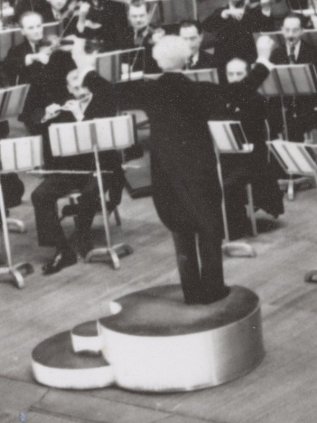This week the Philadelphia Orchestra is commemorating the one-hundredth anniversary of Leopold Stokowski’s appointment as music director with a series of concerts in the Academy of Music. In honor of the occasion, there will be an exhibit on display in the lobby of the Academy, featuring several items from the holdings of the Penn Libraries: Stokowski’s tails, his unusual variable-pitch box, and his podium.

Most conductors’ podiums are nondescript—simple, low-lying wooden boxes—but when designing his podium, Stokowski worked against tradition, as he did in many other areas of his career as a conductor. His podium is round, with round stairs leading up to the platform. A cutout in front cradles the base of the conductor’s music stand to keep it stable and close to the conductor. The sides of the podium appear to be metal, but they’re actually wood that is painted a shiny silver, and the horizontal surfaces are covered with slip-resistant rubber. It has a space-age appearance, and in the 1930s, it must have looked like something taken from a Buck Rogers comic strip.
The podium is part of the Leopold Stokowski Collection, which came to Penn by way of the Curtis Institute in 1997. Stokowski bequeathed his papers to Curtis, and after serving as custodian of the collection for twenty years following Stokowski’s death in 1977, Curtis decided to donate the scores and papers to the University of Pennsylvania, where they joined the scores and papers of Eugene Ormandy and Marian Anderson in the Rare Book and Manuscript Library.
The most substantial part of Penn’s Stokowski holdings is the music he worked with—his collection of conducting scores (Ms. Coll. 350) and transcriptions (Ms. Coll. 351), including his famous Bach transcriptions. These transcriptions are performed by orchestras around the world, and the Penn Libraries provide copies of the original scores and parts for concert performance through a local rental agency.
Although Stokowski’s scores and transcriptions were safely preserved following his death, his personal papers and effects were reportedly lost from the deck of a ship while being sent from England to the United States, and for that reason the Stokowski papers at Penn are limited in scope. Among the most interesting items in the papers is Stokowski’s audition book. He auditioned hundreds of young performers, rated them, and made comments about their performance and potential. The book is undated, but many people who auditioned for him remember it, and it was in use during Stokowski’s years with the American Symphony Orchestra (1962-72).
Since their arrival at Penn, the Stokowski collections have been augmented by additional donations. In July 1999, Stephen Simon, the owner of the house Stokowski built in Beverly Hills, California, in the 1930s, donated materials he discovered behind a trap door leading to the side of the firebox in the living room. Among these materials were correspondence, photographs, notes on plans to form an electric orchestra, notes on his household staff, bank statements, royalty statements, insurance records, and contracts. These date from roughly 1937 to 1946, although some of the contracts are older (as early as 1925). These papers provide a rare glimpse into the conductor’s everyday life after his move to California in 1936.
To learn more about Penn Libraries’ Stokowski holdings, see the online exhibit “Leopold Stokowski: Making Music Matter” as well as the Leopold Stokowski Papers finding aid on the PACSCL Finding Aids site.
–Richard Griscom, Head, Otto E. Albrecht Library and Eugene Ormandy Music and Media Center
Postscript: The Philadelphia Orchestra posted a photograph of conductor Yannick Nézet-Séguin standing on the Stokowski podium on its Facebook page. The photograph was taken before the beginning of the concluding concert of the Stokowski Celebration on Saturday, 23 June 2012.

